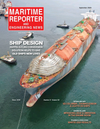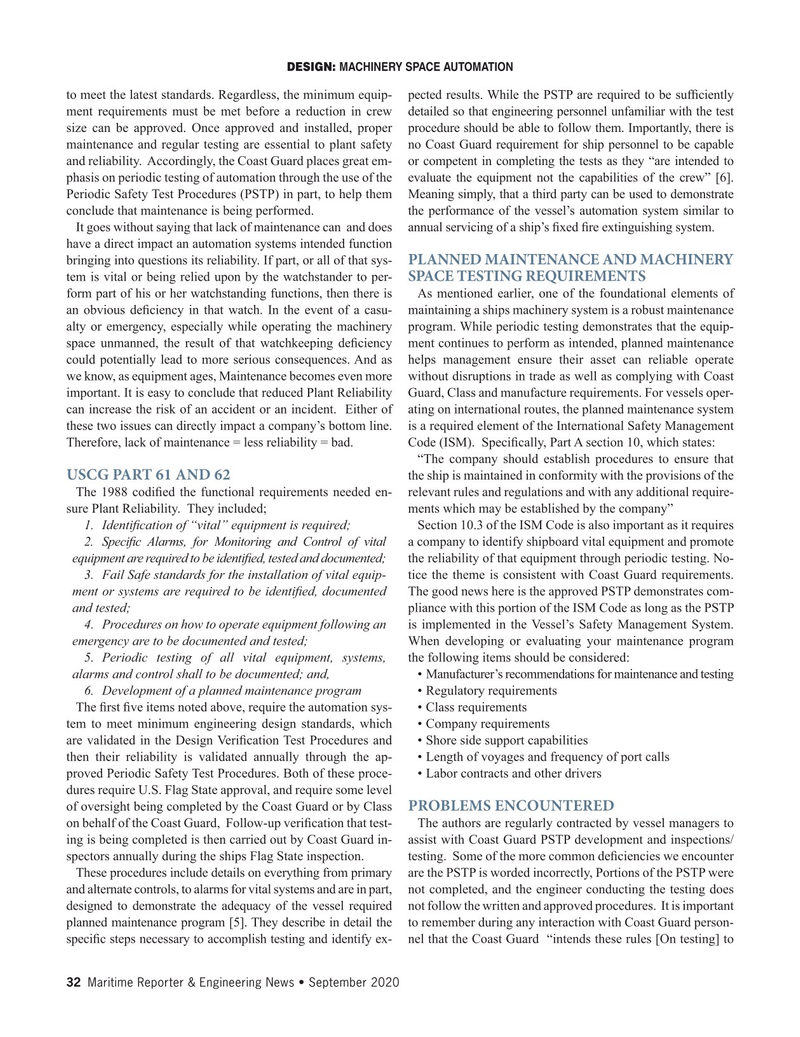
Page 32: of Maritime Reporter Magazine (September 2020)
Marine Design Annual
Read this page in Pdf, Flash or Html5 edition of September 2020 Maritime Reporter Magazine
DESIGN: MACHINERY SPACE AUTOMATION to meet the latest standards. Regardless, the minimum equip- pected results. While the PSTP are required to be suf? ciently ment requirements must be met before a reduction in crew detailed so that engineering personnel unfamiliar with the test size can be approved. Once approved and installed, proper procedure should be able to follow them. Importantly, there is maintenance and regular testing are essential to plant safety no Coast Guard requirement for ship personnel to be capable and reliability. Accordingly, the Coast Guard places great em- or competent in completing the tests as they “are intended to phasis on periodic testing of automation through the use of the evaluate the equipment not the capabilities of the crew” [6].
Periodic Safety Test Procedures (PSTP) in part, to help them Meaning simply, that a third party can be used to demonstrate conclude that maintenance is being performed. the performance of the vessel’s automation system similar to
It goes without saying that lack of maintenance can and does annual servicing of a ship’s ? xed ? re extinguishing system. have a direct impact an automation systems intended function bringing into questions its reliability. If part, or all of that sys- PLANNED MAINTENANCE AND MACHINERY tem is vital or being relied upon by the watchstander to per-
SPACE TESTING REQUIREMENTS form part of his or her watchstanding functions, then there is As mentioned earlier, one of the foundational elements of an obvious de? ciency in that watch. In the event of a casu- maintaining a ships machinery system is a robust maintenance alty or emergency, especially while operating the machinery program. While periodic testing demonstrates that the equip- space unmanned, the result of that watchkeeping de? ciency ment continues to perform as intended, planned maintenance could potentially lead to more serious consequences. And as helps management ensure their asset can reliable operate we know, as equipment ages, Maintenance becomes even more without disruptions in trade as well as complying with Coast important. It is easy to conclude that reduced Plant Reliability Guard, Class and manufacture requirements. For vessels oper- can increase the risk of an accident or an incident. Either of ating on international routes, the planned maintenance system these two issues can directly impact a company’s bottom line. is a required element of the International Safety Management
Therefore, lack of maintenance = less reliability = bad. Code (ISM). Speci? cally, Part A section 10, which states: “The company should establish procedures to ensure that
USCG PART 61 AND 62 the ship is maintained in conformity with the provisions of the
The 1988 codi? ed the functional requirements needed en- relevant rules and regulations and with any additional require- sure Plant Reliability. They included; ments which may be established by the company” 1. Identi? cation of “vital” equipment is required; Section 10.3 of the ISM Code is also important as it requires 2. Speci? c Alarms, for Monitoring and Control of vital a company to identify shipboard vital equipment and promote equipment are required to be identi? ed, tested and documented; the reliability of that equipment through periodic testing. No- 3. Fail Safe standards for the installation of vital equip- tice the theme is consistent with Coast Guard requirements. ment or systems are required to be identi? ed, documented The good news here is the approved PSTP demonstrates com- and tested; pliance with this portion of the ISM Code as long as the PSTP 4. Procedures on how to operate equipment following an is implemented in the Vessel’s Safety Management System. emergency are to be documented and tested; When developing or evaluating your maintenance program 5. Periodic testing of all vital equipment, systems, the following items should be considered: alarms and control shall to be documented; and, • Manufacturer’s recommendations for maintenance and testing 6. Development of a planned maintenance program • Regulatory requirements
The ? rst ? ve items noted above, require the automation sys- • Class requirements tem to meet minimum engineering design standards, which • Company requirements are validated in the Design Veri? cation Test Procedures and • Shore side support capabilities then their reliability is validated annually through the ap- • Length of voyages and frequency of port calls proved Periodic Safety Test Procedures. Both of these proce- • Labor contracts and other drivers dures require U.S. Flag State approval, and require some level of oversight being completed by the Coast Guard or by Class
PROBLEMS ENCOUNTERED on behalf of the Coast Guard, Follow-up veri? cation that test- The authors are regularly contracted by vessel managers to ing is being completed is then carried out by Coast Guard in- assist with Coast Guard PSTP development and inspections/ spectors annually during the ships Flag State inspection. testing. Some of the more common de? ciencies we encounter
These procedures include details on everything from primary are the PSTP is worded incorrectly, Portions of the PSTP were and alternate controls, to alarms for vital systems and are in part, not completed, and the engineer conducting the testing does designed to demonstrate the adequacy of the vessel required not follow the written and approved procedures. It is important planned maintenance program [5]. They describe in detail the to remember during any interaction with Coast Guard person- speci? c steps necessary to accomplish testing and identify ex- nel that the Coast Guard “intends these rules [On testing] to 32 Maritime Reporter & Engineering News • September 2020
MR #9 (18-33).indd 32 MR #9 (18-33).indd 32 9/9/2020 8:21:35 AM9/9/2020 8:21:35 AM

 31
31

 33
33
